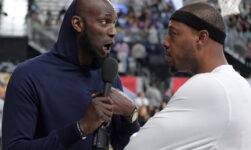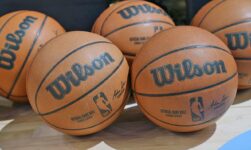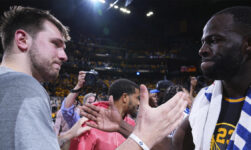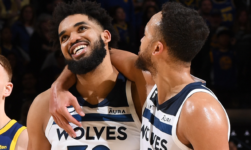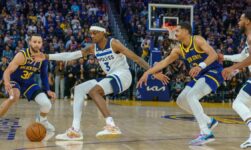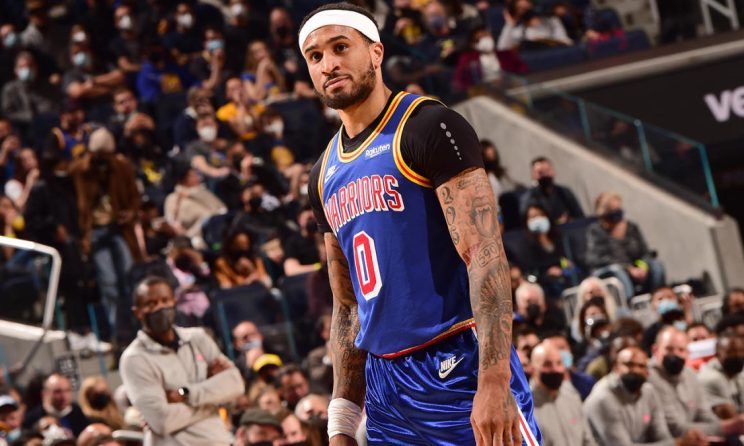
Among Adam DeSautels’ responsibilities as an assistant coach at Westwind Preparatory Academy in Phoenix was helping players find spots at the next level. In September 2011, that meant posting on Blogspot, where he published scouting reports, one of which included a proclamation: DeSautels would be surprised if this particular Westwind player was not named an all-league defensive player at least once in his collegiate career.
When he talked to college coaches about this player, a defense-first, jump-out-of-the-gym combo guard, he could sense their hesitation. “It was weird,” he said, because the film spoke for itself, and, as the player’s English teacher, he didn’t understand how anybody could meet the kid and not like him. Convincing the coaches to make the trip was “like pulling teeth.”
To this day, DeSautels cannot explain why there was such little interest in Gary Payton II. You’d think the son of a Hall of Famer would be overhyped, not underrecruited.
“I couldn’t even get the Big Sky to come look at Gary,” DeSautels said. “His name’s Gary Payton and he’s athletic. So, one, that means I’m a terrible salesperson, but, two, he wasn’t really somebody that people took that seriously.”
Payton was 19 when he got to Salt Lake Community College, 23 when he went undrafted out of Oregon State and 29 when his one-year contract with the Golden State Warriors was guaranteed last Monday. Until recently, he was on the fringes, playing in the G League and summer league, on two-ways and 10-days, never finding a way to stick with one NBA team from training camp to Christmas.
This Christmas, Payton started in the marquee game. When Devin Booker neglected to box him out, he soared to the rim for a powerful putback, the kind of play that looks a thousand times more impressive when the guy making it is 6-foot-3. In the afterglow of Golden State’s victory, Andy Liu, co-host of “Light Years,” a long-running Warriors podcast, changed his Twitter display name to “Gary Payton II Stan Account.”
“It’s just an unforgettable season,” Payton said on Jan. 10, the day he officially kept his spot, just before the team plane departed for Memphis. “My first locked-in season, guaranteed. And with this team. It’s special guys on this team.”
Payton has seen the Chase Center crowd give him a standing ovation and heard it chant his name. He has harassed opposing stars from Chris Paul to Nikola Jokic, won a jump ball against the 6-11 Jonas Valanciunas, dunked so hard he got headbutted and earned a new nickname. (YoungGlove is Payton-approved, as are The Thief and GPII, he’s Little Gary to family, don’t even think about calling him The Mitten.)
“He’s hard to define, so the things that he does on the court have to be pretty special,” Golden State assistant coach Ron Adams said. “And he’s carved out this niche that works for him and is extremely helpful to a team.”
Even the Warriors, however, underestimated him. If they knew this was coming, they wouldn’t have let him go twice. In Payton’s view, he’s “been doing the same thing for a few years now.” So why in the world didn’t this happen sooner?
“I am just as curious as you are,” Payton said. “I have no idea what took so long.”
Payton is proud of the fact that he broke out so close to turning 30. There is not an exact age when executives stop seeing you as a “prospect,” but it happens.
“They definitely look for younger guys to breed and make them their future,” he said. “But if you think about it, I didn’t really start playing basketball until my senior year of high school, so I don’t have really that much wear and tear on me. I’m pretty athletic still. I can still move pretty quick.”
Looking back, Payton thinks his late start has something to do with why, after so much rejection, he is still here. “I realized young I was a late bloomer,” he said. “Gains are going to come.” When his younger brother, Julian, started going to the gym with Darrel Jordan, Payton was still staying home to play video games.
To Jordan, who trained Payton and coached him with the Hard 2 Guard AAU team, the term “late bloomer” is insufficient. “It was more of a confidence thing,” he said. Payton had big, strong hands and a long wingspan, attributes that, along with a competitive streak honed at family game nights — think 50 push-ups if you lose a round of Golden Tee — he used to great effect on defense. He had a nose for the ball and a knack for being in the right place. What he didn’t have was an identity.
Gary Payton II is soaring in Golden State
Getty Images
“I think Gary fell in love with basketball when he realized, ‘I just have to be Gary, I don’t have to be The Glove,'” Jordan said. He was the Draymond Jr. of KeyArena, but cruel taunts and comparisons to his father followed him from school gyms and playgrounds in Seattle to Milwaukee, Los Angeles, Boston and Las Vegas. As a high school freshman, he asked Gary Payton Sr. to stop coming to his games. Jordan said Payton’s fear early on was disappointing his dad “by not scoring 40 points.”
In his senior year at Spring Valley High School, Payton started at small forward in a lineup composed entirely of players 6-2 and shorter. “He was everything for us,” coach Phillip McAlister said. “We let him freelance, and some nights we had him in the 5 spot on the board.” They ran a 4-out offense, played opposing bigs off the floor and attacked the paint. He defended Bishop Gorman phenom Shabazz Muhammad and held his own.
Payton was not a bucket-getter, but he was “a chameleon,” McAlister said. “Every night, he could be something else for you. He could give you 10 assists or one night he could give you 15 rebounds or one night he could give you a triple-double.” He’d also grown to 6-2 and he had springs. The game becomes more enjoyable when you can dunk on dudes’ heads.
To hear Coby Karl tell it, Payton has been on a journey of self-actualization through basketball. When Karl first met him, Payton was a 2-year-old learning how to walk. Around that time, Payton made his first appearance in Sports Illustrated. Karl and Payton both grew up behind the scenes with the 1990s Seattle SuperSonics, for whom their fathers were the cantankerous coach and the loudmouth star point guard.
They met again at summer league, Karl a player in his early 20s, Payton a teenage ballboy, an experience he describes as “lit.” The next time their paths crossed, Payton dropped 51 points against the team Karl was coaching in the G League. Karl learned the following season, when Payton joined his South Bay Lakers on a two-way contract, that scoring explosions like that didn’t come naturally. Sometimes, Payton could “do whatever he wanted to do on the court,” Karl said. “Other times, he was “completely flat” offensively. He was quiet around his new teammates, and it wasn’t clear whether or not he was paying attention.
Karl considers Payton unique among all of the players he has coached. As a result of their upbringings, though, he could relate.
“Both of our dads, in a way, are f—ing crazy,” Karl said. “That’s where we connected. And both of us went the opposite direction.”
Payton remembers those conversations vividly and calls Karl a “real huge influence and just somebody I can talk to.” They discussed how “we don’t want to be like our fathers — in terms of a more outward personality,” Karl said, but “we fell in love with the game of basketball being around it. The energy in the arena, the joy of doing something special with your team and being part of it.”
They’d also seen the intensity of that life, the time on the road and in the gym, and the toll that can take on a family. Payton had no interest in being in the limelight.
Karl came to think that Payton was downplaying his basketball IQ by acting casual. Payton had been a leader in high school and college, but came into every new locker room hyper-aware of people’s preconceived notions about him. He was never going to give anyone a reason to say that Gary Payton’s son walked in like he owned the place. Other people’s ideas about how many points he should’ve been scoring “wore on him for a while,” too, Karl said.
“Prep school to college, guys were just telling me, even my dad was [saying], ‘Be aggressive, try to score,'” Payton said. “And I would always tell people, ‘I’m my own guy.’ I’m not a one-on-one player, but I can do a lot of different things at an elite level and help my team in many different ways.”
Payton played point guard at times in South Bay, but the staff recognized immediately that he preferred to play off the ball. “His special stuff” — the putbacks, the backcuts, the secondary plays — happens when “you don’t have all the eyes on you,” Karl said.
And when the team started preparing for playoff games, “he knew every single detail that we went over,” Karl said. He even “started calling guys out” when he needed to. He recognized that, when he sees things his teammates can’t, it’s his responsibility to share them.
By the time Payton was playing for Raptors 905 in the 2021 G League bubble, he had become something of a chatterbox, even when he was injured. Standing on the sideline and calling out defensive coverages, “he was the best coach we had,” 905 assistant coach John Bennett said.
When Payton was on the way to winning G League Defensive Player of the Year at Disney World, Bennett asked the other 905 coaches a question: “Why couldn’t he do what Bruce Brown is doing right now?” Brown, a 6-foot-4 former second-round pick, had reinvented himself as a “point-center,” screening, rolling and cutting his way to a key role on a championship contender.
At the G League level, Payton was already doing all of this. He played 1 through 4 for the 905, depending on who else was available. There was no big discussion about having him set screens or play in the dunker spot. “We fell into it,” Bennett said, and it worked.
“They knew that my IQ was very high down there in that position and I can play out of it,” Payton said. “So we just rocked with it.”
Payton finished like a big and bothered bigger players. Regardless of position, he was making a difference. “‘Just find a way to play him’ really is what it turned into,” Bennett said.
The same thing had happened at previous stops. In South Bay, Karl put him on Caleb Swanigan, and the burly center “couldn’t catch the ball because Gary’s too quick and too smart.” Swanigan did catch it late in the fourth quarter, but when he tried a post move, Payton swatted his hook shot away.
Golden State has a high-level role player who was hiding in plain sight
Getty Images
Early this season, Payton posterized a poor Pelican off a drop step, at which point 2K should have immediately maxed out his standing dunk rating. Former Beavers guard Langston Morris-Walker saw him pull off the same thing in college, out of a post-up.
“I’m like, ‘Bro, what? Our centers can’t do that,'” Morris-Walker said. “We were always kind of like, ‘Bro, you’re a power forward. Bro, you are a center.’ And he loves it. And that’s why I love Gary so much and the reason why I love the way he approaches the game. Because there’s no position for him. There’s zero position for Gary.”
In Payton’s second year of junior college, SLCC coach Todd Phillips planned to make him the point guard and the No. 1 option. “The schools recruiting him wanted him to be the 1, Dad wanted him to be the 1,” Phillips said. Payton was happy letting walk-ons bring the ball up, and only shifted to point when the other point guard got injured.
Bigs have always wished they were guards, and, increasingly, they get to play like they are. The opposite has almost never been true. In December, Curry called Payton “the tallest 6-3 guy in the world.” Payton would like a few more inches, so he could spend even more time in the paint.
“It’s fun to play the dunker spot and be a big presence down there at my size,” he said. “I enjoy it a lot actually, playing in the dunker. But it’s just me being myself.”
Adams had not seen Payton play extensively when Golden State signed him, but “when you get these guys who you don’t know that well, and then you see what they can do, it’s really delightful.” Adams said that coach Steve Kerr is “really good at looking at someone and saying, ‘How can this player help us and how I can help him in our format?'” Payton is the only 6-3 vertical spacer in basketball, so the Warriors designed a lob play for him.
“Little Gary reminds me of the dog that’s behind the fence that’s just sitting there and not barking,” Chris Farr said. “But then you come through that gate, he’s going to tear your head off. That’s how Little Gary has been all his life. His dad gives you a warning — his dad will give you a warning by barking. He don’t give you no warning.”
Watching him play defense, Farr recognizes how much it bothers Payton when he gets scored on. “Some things, you just inherit,” he said. Farr grew up with Payton’s father in Oakland and has known Payton since birth. In 2015, training with Farr at a Merritt College gym in the hills of East Oakland after his first year at Oregon State, Payton found himself guarding an NBA All-Star.
“He took on every single challenge,” DeMar DeRozan said. “And that’s one thing that always stood out. Even some of the most talented players don’t have that aggression and drive that Little Gary had.”
“We would go at it one-on-one,” Payton said. “I kind of surprised myself a few times back then,” he said. “Just stopping DeMar, it was just like, ‘It’s DeMar, I’m getting a couple stops here.’ But you know, he is DeMar and he did get some buckets, of course.”
DeRozan counts Payton’s father as a mentor, dating back to when he was a 16-year-old high school star and “when Little Gary was a kid, man,” he said. DeRozan followed Payton’s career as he bounced around and respected that he was “never timid,” regardless of the situation he was in.
“He’s always been the same good, kindhearted person,” DeRozan said. “Soft-spoken. He’s not loud and crazy, obnoxious like his father,” DeRozan said. “He’s definitely the opposite of it, but with the same intensity internally.”
Now that Payton is a Warrior, DeRozan watches “every one of those games,” he said, unless it conflicts with a game of his own. “And I’ve been rooting for him, even if I don’t tell him personally.” DeRozan was not surprised in the least when, on Nov. 12 in San Francisco, he took a seat on the bench and saw the Warriors go to a box-and-1 defense, with Payton on Zach LaVine.
Payton stuck to LaVine like a bad reputation, He face-guarded him, chased him over screens and swiped at the ball when LaVine managed to get it.
“That’s just completely him,” DeRozan said. “He was raised from that. That’s who he is.”
The second that he presses up on a ballhandler, Payton wants him to think one thing: “Help me.” There is a certain satisfaction every time he forces someone to call for a teammate to bring the ball up and initiate the offense.
The goal of the box-and-1, deployed liberally by Kerr’s staff, is to take the opposing star out of the play and the opposing team out of its comfort zone. It works a lot better when the “1” is an unscreenable menace who loves nothing more than locking down.
“It’s been a hell of a tactic,” Payton said. “And yes, it’s fun as hell.”
For a few months in 2018, two of the best perimeter defenders on planet Earth played their home games at a 750-capacity practice facility. When Alex Caruso was with Payton in South Bay, there were “nights where it was really difficult for other teams to run offense,” Caruso said. They had immediate chemistry, and they shared a “no-fear mindset” and a knack for getting deflections.
Payton had all sorts of “elite skills,” Caruso said. He could rip the ball away from somebody on any given possession and, then, three seconds later, he’s mid-air, contorting himself to throw down a reverse dunk.
“The stuff he’s doing now in these games, he was doing in the G League, but, like, crazier,” Caruso said. “He was doing reverses, we were running lob plays out of timeouts for him, he’s pinning shots on the backboard.”
Payton made plays on both ends, on and off the ball. He was an “excellent rebounder from the guard position,” Caruso said, and an “elite cutter.” He took the right shots, made the right reads.
These are, in sports parlance, the little things. But maybe we shouldn’t call them that.
“Those are things that not everybody in the league can do,” Caruso said. “A lot of people in the league can shoot or dribble or make plays for others, but it’s hard to rebound. It’s hard to cut. It’s hard to play with timing off of superstars.”
Before Payton got his chance in Golden State, he watched Caruso make the absolute most of his in Los Angeles. “They trusted him, they let him be him,” Payton said. “I took that pretty close to the heart and it just motivated and gave me more fire to keep going.”
To Caruso, self-belief is an elite skill, too, especially in the G League. “There’s always a bit of frustration,” Caruso said, when you’re that close to what you want. It takes “mental fortitude” to figure out who you are as a player, stay focused, stay committed, stay positive and just … wait.
“Not everyone can do it,” Caruso said. “That’s the reason I’m here and that’s the reason he’s there.”
Payton and Caruso have remained close since South Bay. A friend of theirs, Toronto Raptors forward Isaac Bonga, is trying to follow their lead. Over and over again in calls and texts, Payton tells him to “stay the course.” On a recent assignment with the 905, Bonga said he remembered how Payton had stayed in the moment and enjoyed himself when they were teammates with the Wizards. He was trying to approach the G League the same way.
“Stay the course is the motto, for sure,” Payton said. “It’s going to be bumpy. It’s going to have potholes and dirt roads or whatever it might be, but stay the course. Don’t fight it. Just take the punches. It can’t last forever.”
Every day of his professional life until last Monday, Payton woke up without a guaranteed contract and a secure role. Most of that time, he had no idea when his next opportunity would come or what it would look like. Nonetheless, there was “nonstop sacrifice,” he said, the same eat-gym-sleep routine in the summer and eat-gym-sleep-travel routine during the season.
“You’re putting everything in one basket,” Payton said. “You’re saying that I’m just going to go for this, put everything I got, regardless of if it happens or if it doesn’t. Not knowing, but just continuing to do the same thing over and over.”
That persistence inspires Bonga. It even inspires DeRozan.
“I’m going to go back to my Freddy VanVleet quote: You gotta bet on yourself,” DeRozan said. “You have the utmost confidence, but with the utmost confidence, you’re just understanding you’re putting in the work. And he works his ass off.”
The way DeRozan looks at it, “sometimes you’re not going to open the right door, sometimes you gotta go through a couple doors.” In Payton’s case, “it sucks that he didn’t stick in those other places,” but “it got him to where he’s at now.” The journey is what makes you appreciate the destination.
“It’s not too many people who’s willing to go through those things and continue to keep pushing and working and working and working and never stop, so when their opportunity comes, they’re going to make the most out of it,” DeRozan said. “I love those stories more than anything.”
Gary Payton II fits like a glove with the Warriors
Getty Images
Viewed from a different perspective, every underdog story is about a bunch of stupid obstacles that never should have gotten in the protagonist’s way in the first place. So, again: Why in the world didn’t this happen sooner?
“It’s such a judgmental league,” Adams said, “with people having these various he can’ts associated with their play. And it’s unfortunate. But a lot of that is hyperbole.”
Payton’s he can’t: He had shot 25.6 percent from 3-point range in the NBA and 27.4 percent in the G League when the Warriors signed him, on relatively low volume.
“I just got a sense that people were hung up with his inability to shoot,” Karl said. “It bothered too many coaches, too many organizations. Like, ‘What are we going to do with this guy who can’t shoot? He’s just a liability.’ So, yeah, I think it’s just a lack of creativity, a lack of understanding where he’d fit in.”
Karl has always enjoyed coaching players like Payton because, sometimes, the narrative about them opens up possibilities. Payton’s vertical leap isn’t the only reason why the Warriors’ lob play was effective. They ran it when the opposing team tried to hide a big or a poor defender on him.
When NBA executives called Oregon State coach Wayne Tinkle about Payton, the questions were always the same: Can he be a primary ball handler? Can he be a pick-and-roll guy? What about his shooting? “We knew he’d get better,” Tinkle said. “But his strengths! I kept saying, ‘Focus on his strengths.'”
Payton shot terribly from deep with the 905, but he “took the right ones when he did shoot them,” Bennett said. He didn’t gum up the offense by cutting on top of drives or hesitating when he was open. He also shot 68 percent inside the 3-point line.
Instead of looking at Payton’s height and weight and thinking he had to play one way, a team needed to be “daring or bold enough” to do something different, Bennett said. “I think a lot of people get a little bit scared. It’s easier to pick the 6-8, 6-9 dude and see if they can make that work, even though he may not be as talented as Gary.
“And then also Bruce Brown doing what he did obviously didn’t hurt.”
Last April, after Payton’s second 10-day contract with the Warriors expired, Payton asked Morris-Walker how to get into sports marketing. Morris-Walker, who works for Adidas, reminded him that he’d played in a nationally televised game two days earlier. “Yo, people like you aren’t just working regular jobs like me,” he told Payton.
Morris-Walker was with him at the NCAA Tournament. He was with him and Farr — and the Warriors’ Damion Lee — in East Oakland for beach runs, morning weightlifting and the most grueling workouts of his life in preparation for the draft. He was with him playing backyard basketball, unable to dribble, doubting his own ability. “He is the only person,” Morris-Walker said, who has ever “made me — and others — feel so weak when you’re playing one-on-one.”
It was about 11 o’clock at night, and Payton needed a pep talk. This is how Morris-Walker remembers it, anyway. Payton said he was thinking about life after basketball, but not in an immediate sense. “Maybe he wasn’t serious on his side,” Morris-Walker said later. “But for me, it felt super serious. He was trying to figure out what was next.” When they’d talked after Payton’s previous professional disappointments, it never got this real. “He was in a dark place.”
The Warriors told him they’d review their options, and they might give him a call. Sure enough, they did, and he signed his non-guaranteed deal 17 days later. In the summer, he rented an Airbnb close to Chase Center.
“I was going to make sure I was going to be here,” Payton said. “I didn’t leave all summer. I made sure that these guys saw me every day.”
Payton badly wanted to “start from the beginning,” he said, and “prove to the staff and the front office that I can fit in the system and that I can help the team win.” He worked on his jumper and his shot preparation with Adams and fellow assistant coach Nick Kerr. When he went home to Vegas, it was to play for Golden State’s summer league team.
Before camp, Payton told Bennett that he just needed somebody to take an educated gamble on him. The Warriors’ gamble that no one would claim him off waivers was not what he had in mind. After cutting guards Langston Galloway, Mychal Mulder and Avery Bradley, they waived Payton, too, only to sign him to a one-year, non-guaranteed deal three days later, just in time for opening night.
The next day, Payton went to the Warriors’ former home, the renamed Oakland Arena, to see — and meet — J. Cole. When they spoke, it was Cole who was talking about a show Payton had put on.
Cole told Payton he was watching on Dec. 23, 2019, when he walked into Madison Square Garden and put up 10 points, 11 rebounds, five assists and six steals.
“He literally told me my story and my journey and I’m still shocked about that,” Payton said. “It’s just crazy. I would’ve never thought it. It’s unbelievable. I have no words for it. It hit different. It’s wild.”
Payton had flown from Vegas, where was playing in the G League Showcase, to D.C., then hopped on a train to New York (Payton’s review: “Dope; I liked it a lot, actually”) for his Garden debut in a No. 20 jersey he didn’t choose.
“I’d been waiting,” Payton said. “It’s just a dream to be able to play there. Magical things happen at MSG.”
“He was just so active,” Bonga, who started for the Wizards, said. “At the time I was like, ‘Oh, shit! Like, he kind of reminds me of his dad.’ But no, he’s special. He’s definitely special.”
Payton stayed in the rotation for six weeks, started 17 games and felt like he’d shown that his game was where it needed to be. Then the Wizards traded for Shabazz Napier, assigned Payton to the G League’s Capitol City Go-Go and removed him from the rotation. His season ended when he tested positive for COVID before the team left for the Orlando bubble.
On the night of the 2016 draft, Payton’s family and friends gathered at Topgolf in Las Vegas and did not hear his name called. On the top floor, Payton told Jordan that he knew everybody was upset, but he wasn’t, and that it was still going to work out. Then he got a FaceTime call from James Harden, who told Payton they were about to be teammates.
The Rockets signed Payton to a three-year, non-guaranteed deal, then cut him in camp. His mother, Monique, told The Undefeated that Harden and the Rockets had assured him he didn’t have to worry about being cut, a story that Payton would not confirm. He did say, however, that this was the cut that hurt the most.
The Milwaukee Bucks cut was a close second. They called him up from the Rio Grande Valley Vipers late in his rookie year on the same kind of deal he signed with the Warriors at the end of last season. They waived him in camp, too, but brought him back on a two-way contract. When Milwaukee cut him loose for Sean Kilpatrick in December, Yahoo Sports reported that it was an unpopular move in the locker room.
“It happens like that sometimes,” Payton said. “But that one hurt just probably because I felt like I had got a lot better. I think I did everything I could do make that roster.”
Every time a team let him go, Payton told himself his time would come. “You talk to yourself and you set that motivation,” Payton said. He didn’t have to stick with it for financial reasons, but that was never why he played anyway. At a certain point, the investment he’d made became a source of inspiration in itself.
“I had already put in so much work just to throw (away) all of the pain, sweat and the soreness, hurt bodies, long travel days, the G League travel, taking buses, flights getting canceled, everything, and just decide to do something else,” Payton said. “So it was just like a mental thing for me. You already put yourself through this, you might as well reap the reward and be able to play on this platform, with these players — the best players in the world — on the biggest stages, and just have fun. So that’s probably why I just stuck it out and said, ‘Why quit now?'”
Leading up to his guarantee date this season, Payton mentioned it in numerous interviews and even tweeted, simply, “January 10th.” He sent the tweet more than a month after he had become an every-night rotation player and hours after I’d asked him if he was bringing up the date to trick himself into feeling like he hadn’t already earned the spot.
“I guess you can say that,” Payton said. “But I just know from previous situations, you can’t take anything for granted. And that’s the date where they have to make a decision. So I’ve been in that position, where teams have to make a decision, and it hasn’t gone my way. So yeah, like you said, I’m just continuing to remind myself that that’s the date. I can’t let up. I can’t get comfortable.”
Payton said he wanted there to be absolutely no question this time. He wanted the Warriors to be “basically forced to keep me.” When I asked him what his most memorable moment of the season was, he said, “I’ll let you know January 10th” and laughed.
On Jan. 6, when Kerr confirmed to the media that Payton wasn’t going anywhere, Morris-Walker sent him the news. Payton told him that he loves Kerr, but has been here before and it’s not real until the day comes.
When the day came, Payton told me that he’d done nothing to celebrate. “Just regularly scheduled program,” he said. The routine stays the same, and now his only goal is a championship.
Early this season, Morris-Walker noticed that, nearly every time he FaceTimed Payton, he was at Chase Center. “He may not be working out,” Morris-Walker said, “but he’s getting treatment, he’s in the cold tub. Literally every time I call him he’s in the gym.” That’s how he knew Payton was happier than he’d ever been.
If Adams, the 74-year-old basketball purist who briefly coached Payton Sr. in Boston, is any indication, Golden State is just as pleased to have him.
“You just fall in love with Gary,” he said. “He’s got a great personality. He’s great with his teammates. He’s fun, he’s engaging.”
It has been particularly fun, Adams said, to see Payton integrate “his rogue, natural instincts defensively, which he’s always used, into our schematics” over the course of the season. Assistant coach Mike Brown is working with him on that, and the staff is “trying to help him not beat himself up” when it comes to his shooting. Payton has high expectations for himself, Adams said, but “it’s not tennis. And he does a lot of other great things.”
The Warriors value those things. They move, they pass, they cut, they screen and they improvise most of it. For players who aren’t used to operating in a react-and-react system, it is a massive adjustment. Some talented, highly paid ones have been unable or unwilling to play their way. When they brought in Payton on a 10-day, “our management team came to us and said, ‘Hey, this is a really unique guy,'” Adams said. “We don’t quite know what he is, but we think he’ll fit in.”
For years, Payton thought that playing this style of basketball, with players of this caliber, would help his game. To bring the best out of him, you have to let him “just be alive” on offense, Morris-Walker said. And on the other end, you must sometimes allow him to break rules and “just get shit done,” Karl said.
“At first you might have doubts,” McAlister said, but if you trust him, he’ll perform. “Just let Gary be Gary. You can’t just put him in one spot and say, ‘Yeah, that’s what you have to do.’ You just have to let him do his thing. And then he makes you look like a genius.”
Standing at the scorer’s table in Memphis last Tuesday, Payton turned his head to give a death stare to a heckler who had repeatedly screamed, “The Mitten!” He has not, however, heard that he has to be more aggressive in some time. Everybody around him has “realized I get my points and my buckets the way I get ’em, and I’m aggressive in my own way,” Payton said.
“Master P told me a long time ago, he did a concert and nobody’s there, everybody’s left,” Farr said. “But he saw one or two people bobbing their heads. He needed to go on with his music. And that’s what’s happened to Gary. He found one team.”
The great basketball irony is that the one team that was willing to take a chance on this supposed non-shooter now has Payton shooting 40.3 percent from deep.
“He’s crafted a game that wasn’t based on 3-point shooting,” Adams said. “And at this point in his career he’s spending more time on 3-point shooting than he ever has, and that’s an area that he’s done pretty well in this year and he wants to expand. He wants to groove that shot and add to his offensive repertoire.”
He even has yet another nickname, courtesy of Adams, because Payton has “huge, strong forearms” and “this side-to-side gait, a confident kind of stride,” which reminds him of a cartoon from his youth.
“They all started calling me Popeye,” Payton said. “I was trying to figure it out myself. And I was like OK, what are you guys talking about? And then they told me and I was like, ‘I’m not mad at that.’
“I’m not mad at it. I like spinach, so it’s cool.”


